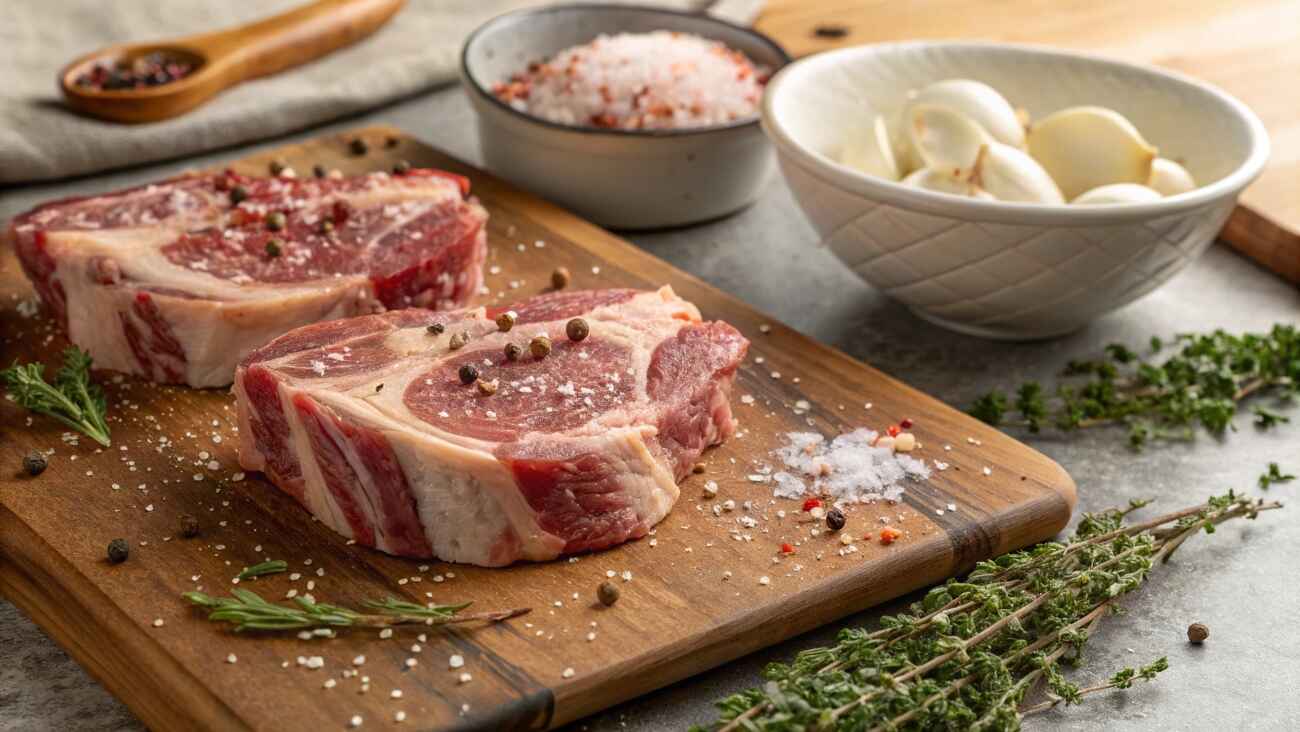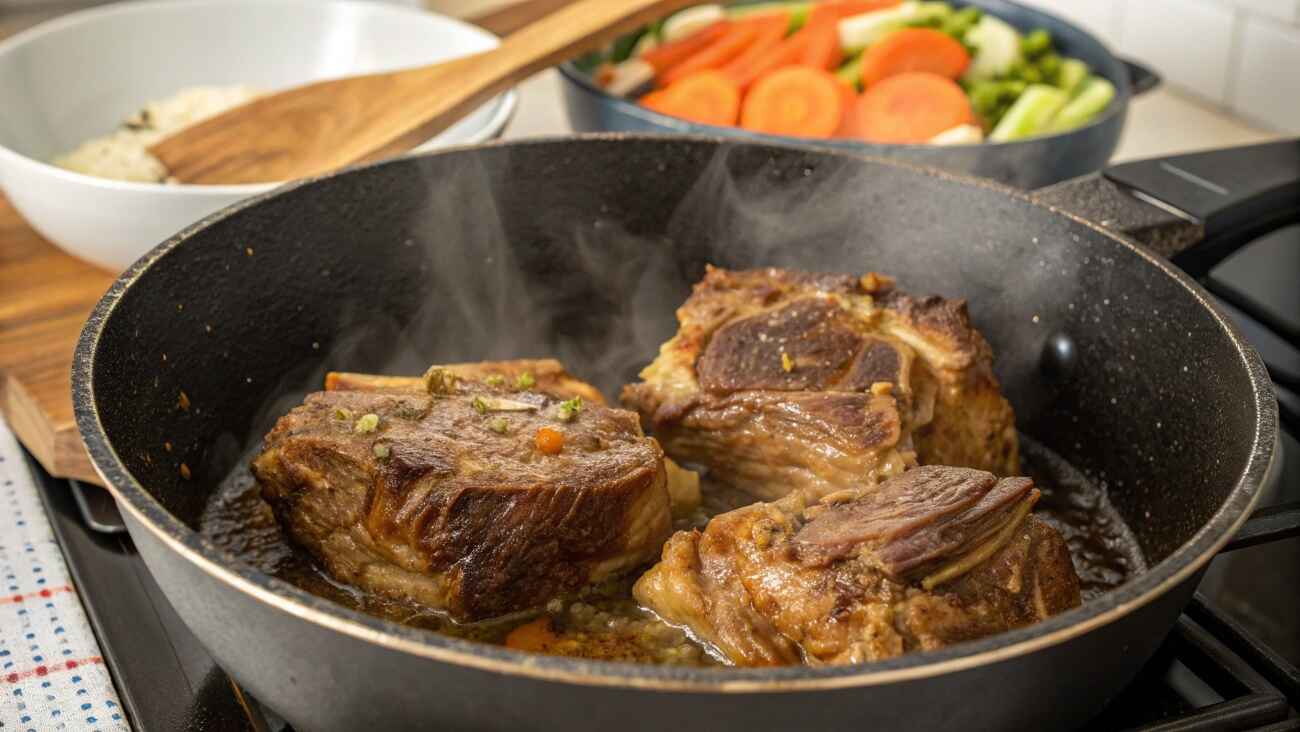Discover why beef neck bones deserve a spot in your kitchen! These affordable, flavorful cuts are packed with culinary potential. From comforting stews to nutrient-rich broths, beef neck bones can transform humble ingredients into gourmet meals. Let’s explore everything you need to know to cook them like a pro.
Table of Contents
“Good food doesn’t have to be expensive. Beef neck bones prove that delicious meals can be made with simple, affordable ingredients!” 🌟
What Are Beef Neck Bones?
Beef neck bones are exactly what they sound like: bones from the neck of a cow. But don’t let their humble origins fool you—these meaty, marrow-filled cuts are bursting with flavor.
Understanding the Cut: Anatomy and Composition
Beef neck bones contain a mix of bone, connective tissue, and a generous amount of meat. When cooked properly, the collagen and marrow within the bones create a rich, gelatinous texture that’s perfect for soups and stews.
Think of them as the unsung heroes of the culinary world. They may not be glamorous like filet mignon, but they bring deep, savory flavors to your dishes that no steak can match.
Why Are Popular?
Beef neck bones are a favorite in kitchens worldwide because they’re versatile, affordable, and incredibly flavorful. Whether you’re making a hearty soup in the Southern United States or crafting a rich broth for Asian-style noodles, neck bones always deliver.
“Cooking beef neck bones is like unwrapping a gift—you never realize how much goodness they can add until you try them!” 🎁
Ingredients
To prepare flavorful and tender beef neck bones, you’ll need the following ingredients:
- 2–3 lbs beef neck bones, cleaned
- 1 onion, chopped
- 3 cloves garlic, minced
- 2 carrots, sliced
- 2 celery stalks, chopped
- 1 tablespoon olive oil
- 1 teaspoon salt
- ½ teaspoon black pepper
- 1 teaspoon smoked paprika
- 1 teaspoon dried thyme
- 1 bay leaf
- 4 cups beef broth or water
- 1 tablespoon Worcestershire sauce (optional)
- 1 teaspoon red pepper flakes (optional for spice)
Step-by-Step Instructions
1. Prepare the Beef Neck Bones
Rinse the beef neck bones under cold water and pat them dry with a paper towel. If needed, trim excess fat.
2. Season and Sear
In a large pot or Dutch oven, heat the olive oil over medium-high heat. Season the neck bones with salt, black pepper, and smoked paprika. Sear the bones on all sides until browned, about 5 minutes per side. This step enhances the flavor.
3. Sauté the Vegetables
Remove the neck bones from the pot and set them aside. In the same pot, add the chopped onion, garlic, carrots, and celery. Sauté until the vegetables soften and become fragrant, about 5 minutes.
4. Deglaze and Simmer
Pour in the beef broth or water, scraping the bottom of the pot to release any browned bits. Add the bay leaf, dried thyme, Worcestershire sauce, and red pepper flakes. Return the beef neck bones to the pot.
5. Slow Cook
Reduce the heat to low, cover the pot, and let the neck bones simmer for about 2.5 to 3 hours. Stir occasionally, ensuring the meat remains submerged in the broth. The bones will release collagen, creating a rich and flavorful broth.
6. Serve
Once the meat is tender and easily falls off the bones, remove the bay leaf and discard it. Serve the neck bones with rice, mashed potatoes, or cornbread, and spoon some of the broth over the top for extra flavor.
Nutritional Value
Beef neck bones aren’t just tasty—they’re nutritious too. Packed with protein, minerals, and collagen, they offer plenty of health benefits.
Essential Nutrients Found in Beef Neck Bones
When cooked slowly, beef neck bones release nutrients like calcium, phosphorus, and magnesium into your dish. These minerals are great for bone health, while the gelatin and collagen support skin elasticity, joint health, and digestion.
Did you know? The collagen in beef neck bones can transform into gelatin during cooking, creating a nutrient-dense broth that’s great for your gut.
Are Beef Neck Bones Healthy? Benefits Explained
Yes, beef neck bones can absolutely be part of a healthy diet. They provide high-quality protein, essential minerals, and natural fats. While their fat content may seem high, trimming excess fat before cooking can make them healthier without losing their flavor.
How to Select Quality
Like any ingredient, the quality of beef neck bones makes a difference in your cooking. Here’s how to choose the best ones.

Fresh vs. Frozen: Which is Better?
Fresh neck bones are ideal if you’re looking for peak flavor, but frozen ones can work just as well. When buying frozen, make sure the packaging is intact and free of freezer burn. Thaw them slowly in the fridge to maintain their texture and taste.
Signs of Fresh, High-Quality
Look for beef neck bones that are bright red, firm, and free of unpleasant odors. A slight marbling of fat is a bonus, as it adds flavor during cooking. Avoid bones that look dull or discolored—they’re likely past their prime.
“Quality starts at the source. Choosing the best beef neck bones ensures your dish will shine!” 🍖
Preparing for Cooking
Preparation is the secret to unlocking the full potential of beef neck bones. Taking the time to clean, marinate, and season them properly will make a big difference.
Cleaning and Prepping the Bones
Start by rinsing your beef neck bones under cold water to remove any bone fragments or debris. If you want to go the extra mile, soak them in cold water with a splash of vinegar for 30 minutes to help draw out impurities.
Pat them dry with a paper towel before seasoning or marinating. If you’re roasting or searing, dry bones will give you a better crust.
Marinating Tips for Enhanced Flavor
Beef neck bones benefit from marination, as it enhances their flavor and tenderizes the meat. Try a simple marinade with olive oil, garlic, rosemary, and soy sauce. Let the bones soak in the marinade for at least 2–4 hours—or better yet, overnight!
Cooking Methods
Ready to turn those humble neck bones into a show-stopping meal? Here are some tried-and-true cooking methods.
Slow Cooking for Tenderness
Slow cooking is the ultimate way to prepare beef neck bones. Toss them in a slow cooker with onions, garlic, broth, and your favorite vegetables. Let them simmer on low heat for 6–8 hours, and you’ll be rewarded with meat that melts off the bone.

Roasting Techniques for Flavor
Roasting beef neck bones caramelizes their natural sugars, adding a layer of depth to your dishes. Preheat your oven to 375°F, season the bones with spices, and roast them until golden brown. Use roasted neck bones to elevate soups, stews, or casseroles.
Braising and Stewing for Rich Dishes
Braising is a classic method for cooking tough cuts like beef neck bones. First, brown the bones in a hot pan to lock in flavor. Then, simmer them in a flavorful liquid—broth, wine, or even beer—until they’re fork-tender. Stewing works similarly but uses more liquid, resulting in a hearty, soul-warming dish.
Best Recipes
Looking for inspiration? Here are some mouthwatering dishes you can make with beef neck bones.
Classic Stew
This hearty stew combines tender neck bones with potatoes, carrots, and a rich broth. Serve it with crusty bread for a meal that’s as comforting as a hug.
Spiced Soup
Add a kick to your cooking with spiced neck bone soup. Featuring bold flavors like cumin, paprika, and chili powder, this dish is perfect for chilly evenings.
Asian-Style Braised
For something unique, try braising neck bones with soy sauce, ginger, garlic, and a touch of honey. Pair them with steamed rice for a dish that’s sweet, savory, and utterly satisfying.
Common Problems When Cooking
Cooking beef neck bones isn’t without its challenges. Here’s how to solve common problems and ensure your dish turns out perfectly.
Why Are Tough?
Tough neck bones usually mean they weren’t cooked long enough. To fix this, return them to the pot and continue cooking until the meat becomes tender. Low and slow is the way to go!
Dealing with Excess Fat or Gristle
Too much fat? Trim it before cooking or skim it off the surface of your dish once it’s done. Gristle, on the other hand, softens during slow cooking, making it easier to eat or remove.
Cost-Effectiveness
Beef neck bones are a dream for budget-conscious cooks. They’re affordable, flavorful, and stretch easily into multiple meals.
Affordable Protein Source for Every Kitchen
Compared to expensive cuts like ribeye or tenderloin, beef neck bones offer incredible value. A small amount of meat and bone can flavor an entire pot of soup, making them perfect for feeding a crowd.
Creative Ways to Stretch in Meals
Get creative! Use neck bones to make broth, shred the meat for tacos, or add them to stir-fries. A little goes a long way, proving you don’t need a fancy cut to make an unforgettable meal.
“Cooking on a budget doesn’t mean sacrificing flavor. Beef neck bones deliver both!” 💡
Frequently Asked Questions
Are beef neck bones tough?
Yes, beef neck bones are naturally tough, but slow cooking them for several hours makes them tender and full of flavor.
Can I cook beef neck bones in a slow cooker?
Absolutely! Follow the same steps for searing, then transfer everything to a slow cooker. Cook on low for 6–8 hours or on high for 4–5 hours.
What dishes can I make with beef neck bones?
Beef neck bones can be used for soups, stews, bone broth, or served over rice and vegetables for a hearty meal.
Can I freeze cooked beef neck bones?
Yes! Store them in an airtight container with some broth and freeze for up to 3 months. Thaw in the refrigerator before reheating.
What can I substitute for beef neck bones?
Oxtails, short ribs, or beef shank can be used as substitutes, though they may have slightly different textures and flavors.
Conclusion
Beef neck bones are an underrated cut of meat that, when cooked slowly, transform into a tender, flavorful dish. Whether used in stews, broths, or as a standalone entrée, they bring deep, rich taste and plenty of nutrients. With the right seasonings and a little patience, beef neck bones make for a satisfying and budget-friendly meal that’s perfect for comfort food lovers.
“Humble ingredients, extraordinary meals—beef neck bones are the proof that simplicity is beautiful.” ❤️

